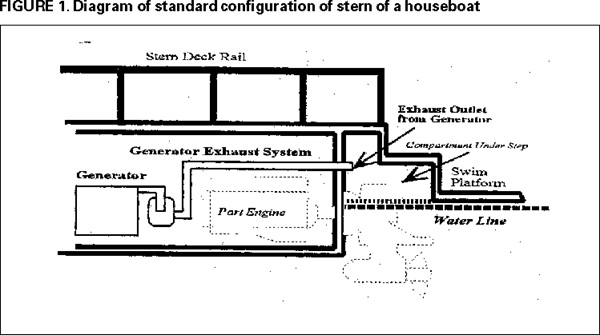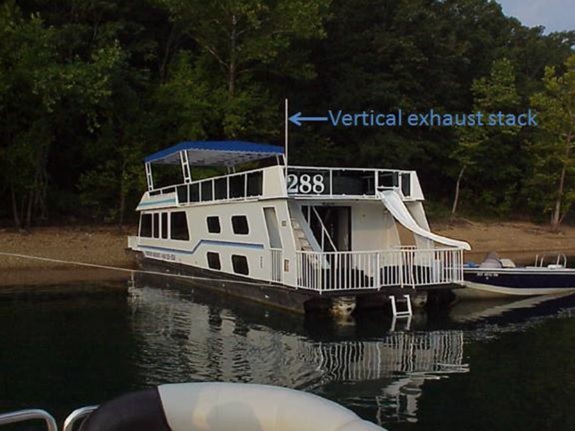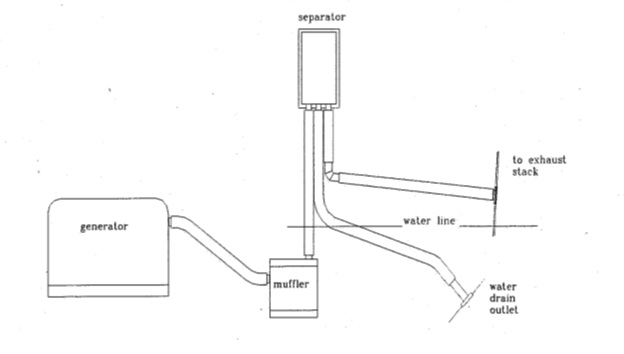Engineering Controls Database
Houseboat Carbon Monoxide Exposure - Generator Emissions Control (Exhaust Configurations)
|
Gasoline-powered generators are commonly used on houseboats to provide electricity for air conditioning, kitchen appliances, entertainment systems, communication equipment, etc. When operating, generators produce carbon monoxide (CO). CO is a lethal poison that is produced when fuels such as gasoline or propane are burned. It is one of many chemicals found in engine exhaust resulting from incomplete combustion. Because CO is a colorless, odorless, and tasteless gas, it can overcome an exposed person without warning. The initial symptoms of CO poisoning may include headache, dizziness, drowsiness, or nausea. Symptoms may advance to vomiting, loss of consciousness, and collapse if prolonged or high exposures are encountered. If the exposure level is high, loss of consciousness may occur without other symptoms. Coma or death may occur if high exposures continue [NIOSH 1979]. During operation of on-board generators (without operation of propulsion engines), concentrations of CO in the airspace under the extended rear deck of houseboats were measured in excess of 30,000 ppm (parts per million). The NIOSH Recommended Exposure Limit (REL) for CO is 35 ppm for full shift TWA exposure, with a ceiling limit of 200 ppm which should never be exceeded [CDC 1988]. The NIOSH REL of 35 ppm is designed to protect workers during an 8-hour workday. NIOSH has also established an Immediately Dangerous to Life and Health (IDLH) value for CO of 1,200 ppm [NIOSH 2000]. |
|
|
Studies by the National Institute for Occupational Safety and Health (NIOSH) have shown that on some houseboats: • The open space under, above, or around the swim platform may contain lethal concentrations of CO if the generator exhaust discharges into this area. • During boat maintenance activities employees may be exposed to hazardous concentrations of CO. Epidemiologic investigations revealed that from 1990 through April of 2008, 309 houseboat related CO poisonings occurred in the United States. Nonfatal poisonings associated with houseboats numbered 283 with the majority of these poisonings being directly attributable to generator exhaust. Of the 309 houseboat-related CO poisonings, 26 resulted in death. More than 800 CO poisonings related to recreational boating in the United States have been identified, and that number continues to increase. [Double Angel 2008] |
|
|
NIOSH researchers evaluated if CO exposures to occupants on or near houseboats caused by gasoline-powered generators may be reduced by: • retrofitting the side-exhaust configuration to vertical stacks extending well above the upper deck • adding generators equipped with catalytic emission control devices This data base summary covers reducing CO from gasoline-powered generators by redesigning the houseboat exhaust stacks from the standard water level side-exhaust configuration (Figure 1) to a vertical stack configuration. NIOSH researchers examined two different designs of houseboat exhaust stacks and compared them to the side-exhaust configuration. The two designs were flagpole and vertical stack (Figure 2). Both of these designs insure that most of the exhaust from the generator will diffuse and dissipate into the atmosphere away from houseboat occupants. Figure 3 is a diagram of a generator exhaust system showing the connection to the exhaust stack that extends above the upper deck of the houseboat.    |
|
| 171-25A; 171-26A; 171-28A; 171-29A; 171-32A; 171-34A1; 171-34A2; 171-36A; | |
|
Double Angel Foundation [2008]. Boat Related Carbon Monoxide (CO) Poisonings. Updated May 2007 – April 2008. http://www.doubleangel.org/documents/NatlCaseListingBoat- RelatedCOPoisoningsMay2007April2008_000.pdf CDC (1988). MMWR 37, supp (S-7) NIOSH Recommendations for Occupational Safety and Health Standards. Atlanta, GA, Dept. of Health and Human Services, Public Health Service, Centers for Disease Control and Prevention, National Institute for Occupational Safety and Health. Hall R, Earnest GS, Hammond D, Dunn KH, Garcia A. (2014): A Summary of Research and Progress on Carbon Monoxide Exposure Control Solutions on Houseboats. June 2014. Journal of Occupational and Environmental Hygiene, Volume 11 Issue 7. McCammon JB, Radtke T, et al. (2001). Letter of February 20, 2001 from J. McCammon, National Institute for Occupational Safety and Health, Centers for Disease Control and Prevention, Public Health Service, U.S. Department of Health and Human Services, T. Radke, U.S. Department of the Interior, and Dr. Robert Baron Prehospital Medical Care, Glen Canyon National Recreation Area, to Joe Alston, Park Superintendent, Glen Canyon National Recreation Area, Page, Arizona. Denver, CO, NIOSH. NIOSH (1979). A Guide to Work Relatedness of Disease. Cincinnati, OH, Dept. of Health Education and Welfare, Public Health Service, Centers for Disease Control, National Institute for Occupational Safety and Health. NIOSH (2000). Pocket Guide to Chemical Hazards and Other Databases: Immediately Dangerous to Life and Health Concentrations, DHHS (NIOSH). NIOSH (2004) Exhaust stack evaluation: An evaluation of two exhaust stack configurations on Table Rock Lake HETA No. 2003-0318-2936. |
|
| 336612 | |
|
carbon monoxide carbon monoxide control technology control technology generator exhaust generator exhaust houseboats houseboats recreational boats recreational boats |
|
|
Both exhaust stacks (vertical and flagpole) performed dramatically better that the standard water level, side-exhaust configuration. During one NIOSH field study the CO concentrations on the upper and lower decks of the houseboat with the vertical exhaust stack were 27 ppm and 17 ppm respectively. The highest mean CO concentrations with the modified flagpole stack were 5 ppm and 2 ppm for the upper and lower decks, respectively. These findings are much lower than the 67 ppm and 341 ppm for the highest mean CO concentrations found on the upper and lower decks of houseboats having the usual side-exhaust configuration. Based on the results of the research studies, NIOSH recommends that when properly designed and installed, the vertical exhaust stack is a viable, low-cost, engineering control that will dramatically improve the safety of houseboat users. |
